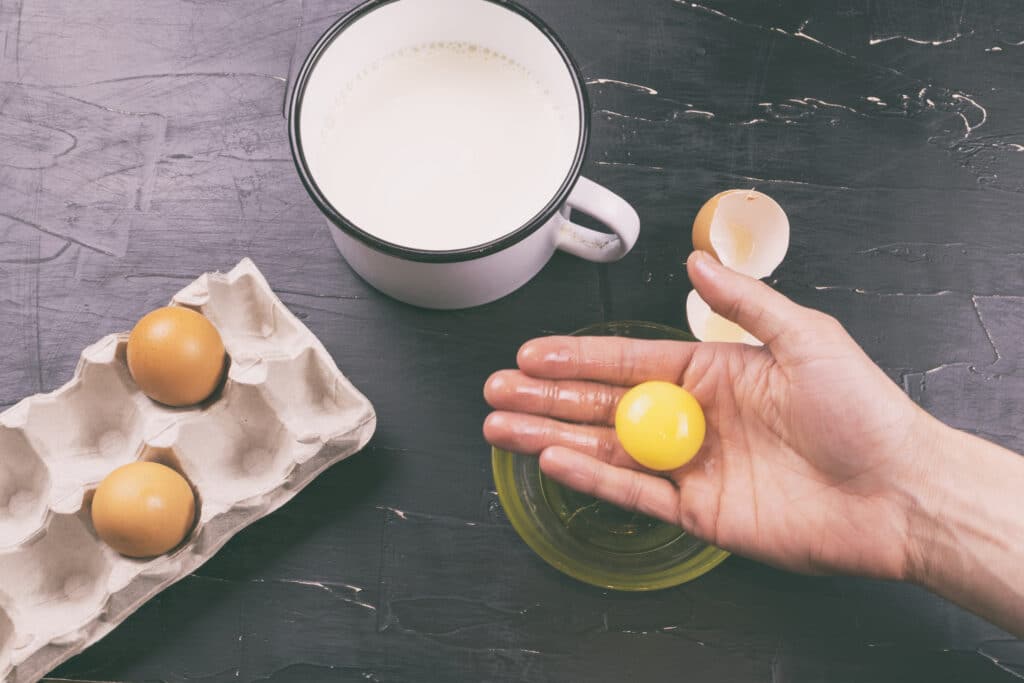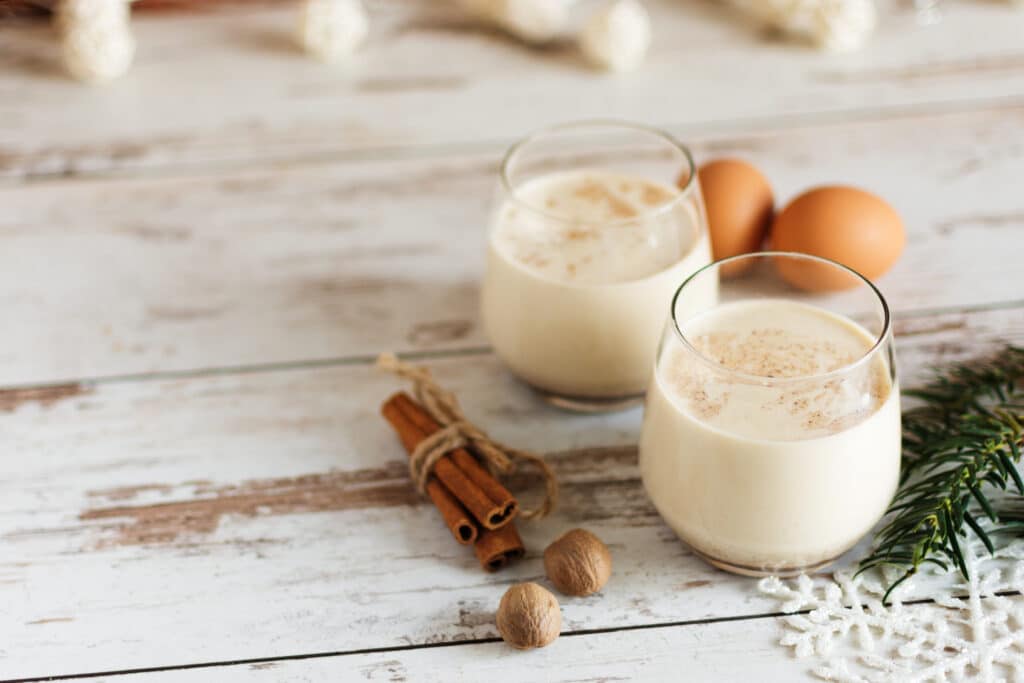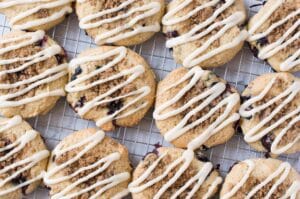Holiday Stress? Drink Eggnog!
Believe it or not, eggnog, a traditional holiday beverage, can help you get through the holidays! Stressed out? Drink eggnog! (And no, I’m not talking about the one spiked with alcohol!)
Eggnog begins to appear on grocery store shelves starting before Thanksgiving these days. There is a plethora of nogs available – those made of organic or conventional milk and “alternative milk nogs”. “Alternative milk” eggnog may be made from coconut milk or nut “mylks”, as well as longtime alternative soymilk. These days, you can even find “eggnog” made from grain milks, such as oat.
I don’t suggest that you pick any of those up for a lot of good of reasons, including the one we all know in our hearts: “homemade is always better”. Store bought eggnogs will not serve your body well. While they may taste like eggnog (or something similar), most of them are full of questionable ingredients, not the least of which are “natural flavors” and fillers, like “guar gum”, “locust bean gum” or “carob gum”. How about a dose of maltodextrin or some mono- and di-glycerides in that glass? These store-bought eggnogs will also pack on the empty calories! Even if they are made with sugar substitutes, none of it is “real food”, and they are very high in carbohydrates we don’t need more of any day! These eggnogs lack everything a real eggnog can offer to your stressed adrenal glands!
Eggnog that you make yourself is highly nourishing! It can be nutrient-dense, depending upon the ingredients you use. I would even call it a “super food”! When you make eggnog at home, you can control the quality of ingredients. You know what you are drinking and what you are serving your children and guests.
Why does “real” eggnog nourish the adrenals? Because it contains egg yolks from pastured hens and whole raw milk and cream. Egg yolks! Yes, egg yolks! A fresh, raw egg yolk is very easy for the body to utilize. It needs no digestion and provides the body with almost every nutrient the body needs! Egg yolks from hens that eat bugs and grass (as they are meant to do) are chock full of nutrients that nourish such as cholesterol, B1 (thiamine), B2 (riboflavin), B6, B12, biotin, vitamin A (the “anti-infective” vitamin), vitamin D, vitamin E, vitamin K2, and more! (Throw out those supplements and eat raw yolks!)
The raw cream and raw milk in homemade eggnog are some of the most nourishing foods. Fresh, unpasteurized, non-homogenized, milk and cream from a dairy where cows graze on grass. Fresh, raw milk and cream will also be full of live enzymes and beneficial bacteria—you won’t find those in eggnogs from a store! They are also full of healthy fat and cholesterol that your body needs to produce the stress hormones you are burning through during this holiday season. Grade B maple syrup will be full of minerals, especially manganese and zinc—another mineral your adrenals really need!
Ready to make your own nutrient powerhouse holiday beverage? Let’s get started with some recipes.

Eggnog from Real Milk and Cream
makes 1 quart
Ingredients
1 quart fresh, raw milk, a combination of raw milk and raw cream (up to 2 cups of raw cream)
5 egg yolks from pastured hens
1-2 tablespoons organic grade B maple syrup (according to taste)
2 teaspoons vanilla extract, organic, (optional)
freshly grated nutmeg to taste
Instructions
Pour raw milk or raw milk and cream into a quart jar.
Whisk the egg yolks in a small bowl, then add to the jar. Whisk to incorporate. Add maple syrup and whisk again.
Pour into glasses, and grate fresh nutmeg on top. Serve and enjoy!
Making Eggnog with Alternative Milk
Eggnog made with alternative milk will not have the same nourishing benefits as that made with fresh, raw milk and raw cream, because it will lack the nutrients found in them.
What if you cannot obtain fresh, raw milk or raw cream? (Check realmilk.com, a project of the Weston A. Price Foundation, to see where you can find raw milk near you.) My best suggestion is to use coconut milk- full fat, “whole”, and contains only coconut and water. There is a wonderful organic coconut cream that is dehydrated and sold in a box- you reconstitute with the amount of water for the consistency you want. Why not pasteurized, organic milk? Milk that has been pasteurized is a challenge for any digestive system, and the cause of many allergies. (Why raw milk is best here: Facts about Raw Milk .)
If you like, you can make your own coconut milk. It is easy and affordable! If you would like to learn how, I outline three ways to make your own in my book, The Complete Cooking Techniques for the GAPS Diet.
Why not commercial nut milk like almond milk or oat milk? All nuts, seeds, and grains have anti nutrients in them that can impair digestion and cause mineral deficiencies over time. I have yet to find a brand that addresses these challenges by soaking, sprouting, or fermenting them as part of their “milk making” process. These traditional cooking techniques help to make all nuts, seeds, and grains (and beans and legumes!) easier to digest. (Learn more.)
If you can find a nut, seed or grain milk that has been sprouted or soaked or fermented, go for it! In the meantime, you could make your own for your “alternative” eggnog. Also, I don’t recommend using store bought rice milk. It is very high in sugar, and a highly processed food!
Homemade Almond Milk!
Makes 2 quarts
Ingredients
2 cups organic almonds, raw best
warm filtered or other pure water
1.5 teaspoons good quality sea salt (high mineral; no “anti-caking” or “flow” agents)
¼ cup whey or ¼ cup water and probiotic capsule
2 tablespoons raw honey (local best)
1 teaspoon vanilla extract, organic, (optional)
pure water, room temperature
Instructions
Put the almonds in a medium bowl and cover with warm water (just under the boil in your tea kettle).
Add salt and stir. Place a plate or dish towel over the bowl and leave at room temperature overnight or longer. When you are ready, put soaked almonds in a dish towel, one handful at a time, and rub the skins off. Discard the skins and place skinless almonds in a food processor with an S blade. Process until smooth.
Place processed almonds and whey and raw honey into a 2 quart jar. Add enough pure water to fill to the shoulder level of the jar. Cap tightly and leave on the counter, out of the sun, at room temperature (68-72°F) for 2 days, or until the cap is taut (you cannot press it down with your finger).
Put into the refrigerator.
When ready to drink, stir well. Taste. Add optional vanilla extract. To use in “alternative” eggnog, you may wish to skip adding the optional vanilla until after you make the recipe.
Note: This recipe typically takes about 3 days to make.
Allow time in your holiday planning to make it!

Oats are especially high in phytic acid or phytate, the substance that binds with minerals in the small intestine and takes them out of your body. (It is one of the anti-nutrients in all nuts, seeds, grains, and beans and legumes mentioned above.) If you like oat milk and drink it often, it is especially important to make your own! Here’s a recipe for 2 quarts.
Homemade Oat Milk!
Makes 2 quarts or more
Ingredients
½ cup organic, rolled oats
8 cups pure water
1 teaspoon good quality sea salt (high mineral; no “anti-caking” or “flow” agents)
¼ cup whey (see recipe below), or use ¼ cup of water with probiotic added (See below)
3 tablespoons raw honey (local is best)
Instructions
Bring water to a boil in a medium saucepot.
Add oats and stir.
Bring back to a boil, then lower heat to a simmer. Cover and cook at a low simmer for several hours (6-8 or more). Check periodically to be sure the oats do not burn and have not run out of water. Note: to make more oat milk, add some boiled water from your teapot occasionally. Stir to combine.
Allow to cool.
Put cooked oats through a food mill, and then place in a 2 quart, wide mouth canning jar. (Depending on how much water you added, you may need two jars, or a larger jar.)
Add salt and whey. Stir to combine and cap tightly.
Leave on the counter, out of the sun and at room temperature (68-72°F) for 2 or 3 days, or until the lid becomes taut (you cannot press it down with your finger).
Taste.
To drink, add more water until you achieve the consistency that you like. You may also add optional honey, above. To use in “alternative” eggnog, you may wish to wait to add honey until after you taste the oat milk in the eggnog recipe.
Note: some separation is normal when fermenting the oat milk on the counter. Also, this recipe typically takes 3-4 days.
Allow for enough time when you plan your holiday menu!
Whey
Makes about 2 cups
Ingredients
1 quart homemade yogurt or kefir, or good quality plain organic whole milk yogurt or kefir, no fillers
1 strainer, preferably cone-shaped
cheese cloth, tea towel, or linen napkin
2 cup liquid measure or bowl to fit strainer
Instructions
Place strainer in liquid measure. Line the strainer with 2 or more layers of cheesecloth or a tea towel or linen napkin.
Spoon yogurt or kefir into strainer. Whey will drip into the liquid measure and yogurt/kefir cheese will remain in the strainer.
Leave on the counter to strain for 12-36 hours. The longer you drip, the firmer the cheese, and the more whey will drip.
Store whey and the cheese in a glass jar in the refrigerator. Whey will last up to 6 months under refrigeration.
Note: One quart of yogurt will yield about 2 cups of whey and 1 cup of yogurt cheese. (Store the cheese in a glass container in the refrigerator. It will last about 2 weeks. Use like cream cheese!)
Salud! Here’s to stress-free holidays and your adrenal health!
If you are avoiding dairy because you have allergies or sensitivities, you can heal the cause with the Gut and Psychology Syndrome Diet.
If you would like more information about cholesterol and to learn why it is critical to your health, please read Put Your Heart in Your Mouth and/or Cholesterol Myths.
Monica Corrado, MA, CNC, CGP is a teaching chef, Certified Nutrition Consultant, and Certified GAPS Practitioner who is passionate about illuminating the connection between food and well-being. A member of the Honorary Board of the Weston A. Price Foundation for almost 20 years, Monica is a dynamic teacher, speaker, consultant, and author who lives to share the tools, knowledge and inspiration to cook nourishing, traditional food. Monica is also The GAPS (Gut and Psychology Syndrome™) Chef”, and teaches cooking for the GAPS diet for Dr. Natasha Campbell-McBride’s GAPS Training team.
www.simplybeingwell.com
FB: Simply Being Well: Cooking for Wellbeing
Twitter: @simplybeingwell
IG: mcsimplybeingwell
Eggnog from Real Milk and Cream
Source: Monica Corrado
Course: Beverages
Yield: 1 quart
Serves:
Ingredients
- 1 quart fresh, raw milk a combination of raw milk and raw cream (up to 2 cups of raw cream)
- 5 egg yolks from pastured hens
- 1-2 tablespoons organic grade B maple syrup (according to taste)
- 2 teaspoons vanilla extract organic, (optional)
- freshly grated nutmeg to taste
Directions
- Pour raw milk or raw milk and cream into a quart jar.
- Whisk the egg yolks in a small bowl, then add to the jar. Whisk to incorporate. Add maple syrup and whisk again.
- Pour into glasses, and grate fresh nutmeg on top. Serve and enjoy!
Homemade Almond Milk
Source: Monica Corrado
Course: Beverages
Yield: 2 quarts
Serves:
Ingredients
- 2 cups organic almonds raw best
- warm filtered or other pure water
- 1.5 teaspoons good quality sea salt (high mineral; no “anti-caking” or “flow” agents)
- 1⁄4 cup whey or ¼ cup water and probiotic capsule
- 2 tablespoons raw honey (local best)
- 1 teaspoon vanilla extract organic, (optional)
- pure water room temperature
Directions
- Put the almonds in a medium bowl and cover with warm water (just under the boil in your tea kettle).
- Add salt and stir. Place a plate or dish towel over the bowl and leave at room temperature overnight or longer. When you are ready, put soaked almonds in a dish towel, one handful at a time, and rub the skins off. Discard the skins and place skinless almonds in a food processor with an S blade. Process until smooth.
- Place processed almonds and whey and raw honey into a 2 quart jar. Add enough pure water to fill to the shoulder level of the jar. Cap tightly and leave on the counter, out of the sun, at room temperature (68-72°F) for 2 days, or until the cap is taut (you cannot press it down with your finger). Put into the refrigerator.
- When ready to drink, stir well. Taste. Add optional vanilla extract. To use in “alternative” eggnog, you may wish to skip adding the optional vanilla until after you make the recipe.
- Note: This recipe typically takes about 3 days to make. Allow time in your holiday planning to make it!
Homemade Oat Milk
Source: Monica Corrado
Course: Beverages
Yield: 2 quarts
Serves:
Ingredients
- 1⁄2 cup organic, rolled oats
- 8 cups pure water
- 1 teaspoon good quality sea salt (high mineral; no “anti-caking” or “flow” agents)
- 1⁄4 cup whey or use ¼ cup of water with probiotic added
- 3 tablespoons raw honey (local is best)
Directions
- Bring water to a boil in a medium saucepot.
- Add oats and stir.
- Bring back to a boil, then lower heat to a simmer. Cover and cook at a low simmer for several hours (6-8 or more). Check periodically to be sure the oats do not burn and have not run out of water. Note: to make more oat milk, add some boiled water from your teapot occasionally. Stir to combine.
- Allow to cool.
- Put cooked oats through a food mill like this one, and then place in a 2 quart, wide mouth canning jar. (Depending on how much water you added, you may need two jars, or a larger jar.)
- Add salt and whey. Stir to combine and cap tightly.
- Leave on the counter, out of the sun and at room temperature (68-72°F) for 2 or 3 days, or until the lid becomes taut (you cannot press it down with your finger).
- Taste. To drink, add more water until you achieve the consistency that you like. You may also add optional honey, above. To use in “alternative” eggnog, you may wish to wait to add honey until after you taste the oat milk in the eggnog recipe.
- Note: some separation is normal when fermenting the oat milk on the counter. Also, this recipe typically takes 3-4 days. Allow for enough time when you plan your holiday menu!




